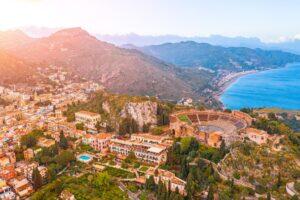Fodor's Expert Review Villa Romana del Casale
The exceptionally well-preserved Imperial Roman Villa is thought to have been a hunting lodge of the emperor Maximian (3rd–4th century AD) and offers some of the best mosaics of the Roman world, artfully covering more than 12,000 square feet. The excavations were not begun until 1950, and most of the wall decorations and vaulting have been lost, but the shelter over the site hints at the layout of the original building. The mosaics were probably made by North African artisans; they're similar to those in the Tunis Bardo Museum, in Tunisia. The entrance was through a triumphal arch that led into an atrium surrounded by a portico of columns, which line the way to the thermae, or bathhouse. It's colorfully decorated with mosaic nymphs, a Neptune, and enslaved people massaging bathers. The peristyle leads to the main villa, where in the Salone del Circo you look down on mosaics illustrating scenes from the Circus Maximus in Rome. A theme running through many of the mosaics—especially... READ MORE
The exceptionally well-preserved Imperial Roman Villa is thought to have been a hunting lodge of the emperor Maximian (3rd–4th century AD) and offers some of the best mosaics of the Roman world, artfully covering more than 12,000 square feet. The excavations were not begun until 1950, and most of the wall decorations and vaulting have been lost, but the shelter over the site hints at the layout of the original building. The mosaics were probably made by North African artisans; they're similar to those in the Tunis Bardo Museum, in Tunisia. The entrance was through a triumphal arch that led into an atrium surrounded by a portico of columns, which line the way to the thermae, or bathhouse. It's colorfully decorated with mosaic nymphs, a Neptune, and enslaved people massaging bathers. The peristyle leads to the main villa, where in the Salone del Circo you look down on mosaics illustrating scenes from the Circus Maximus in Rome. A theme running through many of the mosaics—especially the long hall flanking one entire side of the peristyle courtyard—is the capturing and shipping of wild animals, which may have been a major source of the owner's wealth. Yet the most famous mosaic is the floor depicting 10 girls wearing the ancient equivalent of bikinis, going through what looks like a fairly rigorous set of training exercises.
READ LESS








